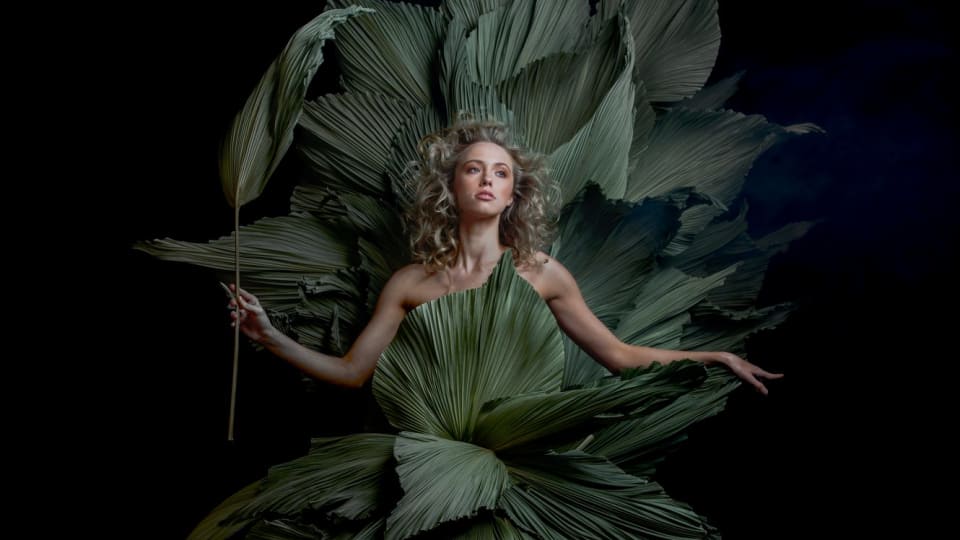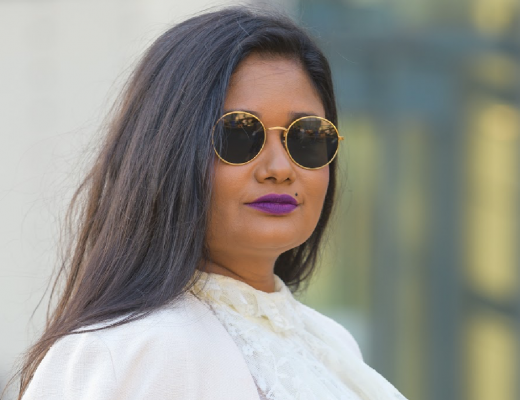The ephemeral realms of flowers and fashion are fantastically intertwined and there is no more lovely proof than on and around the runways of Melbourne Fashion Week, writes Janice Breen Burns. (Longform post: allow 10 minutes reading time.)
(This story first appeared in The Saturday Age’s Spectrum and the Sydney Morning Herald. Main Photo,top: “Lines” by Loose Leaf, an installation at Emporium. Model: Georgia Bennett-Murphy, GIANT; Makeup: Mecca Cosmetica; Botanical design: Wona Bae and Charlie Lawler, Loose Leaf.Photo: Simon Schluter)
Everything that’s happened to floristry in the past decade, its evolution from a boxed-roses and posies business to the heart-pumpingly free art of botanica it is today, couldn’t be better illustrated than here at this cover shoot in a cold Collingwood warehouse, jungly with foliage and draped with curtains of crazily fecund runner-vines.
This is Wona Bae and Charlie Lawler’s Melbourne headquarters and right now, the creative partners in cult botanical art brand Loose Leaf are jostling the last giant robusta palm leaves into their spectacular “frock” sculpture, commissioned as an interactive public installation in the Emporium shopping mall for Melbourne Fashion Week.
They’ve snipped off the leaves’ halo of hairy tendrils and dried them from a bright forest green to a rustling misty-pale sea-foam. And, here’s another thing about robusta even Bae and Lawler didn’t know till they experimented: the leaves’ natural pleating tightens unevenly as it dries, pulling them into graceful twists and curves like silk in a breeze or sea-grass under water.
“One more in here?” Bae murmurs rhetorically. “And here?” The soft-spoken classically trained botanical artist shoves metre-long spears of robusta into gaps in the sculpture’s “skirt” and “cape” as model Georgia Bennett-Murphy gingerly positions herself between them.
Now the illusion, that Bennett-Murphy is actually wearing a gown animated by swirling water, is complete and frankly, mesmerising. Her pale hair, loosely curled, also appears to drift like seaweed and, as a wisp of faux smoke is puffed in behind her, she tries a few slow, elegant movements as it rises, her bare arms supple as spaghetti. The effect is mermaid-esque, utterly delightful. Someone claps. (I think it was me). Could Boticelli’s Venus look as lovely in this weird, vegetable frock? “Gorgeous.” Photographer Simon Schluter is satisfied and manoeuvres to shoot. “Gorgeous.”
Bae and Lawler are equally chuffed. They took a punt on this truckload of robusta for the Melbourne Fashion Week commission and it’s a satisfying outcome in the ephemeral, experimental, ever-evolving world of botanical art. “We want to show a different beauty of the materials,” says Bae, “but you don’t know what will happen til it happens.”
Luckily, the partners’ ambitious experiments have mostly gone gob-smackingly right since they started Loose Leaf five years ago, enough to flesh out their reputation for being rather good at off-beat botanical extravaganzas. Their major work for the international floristry fair, Flora, in Spain last year, was a ranked set of pyramid-shaped sheathes in shaggy asparagus fern strung high and left to gently shed green needles into the courtyard of a 15th century Spanish palace below.

Loose Leaf’s installation for Flora in Spain was suspended in the cool courtyard of a 15th century palace.
“The [life cycle] of materials is a major part of our planning,” Lawler says. “That becomes part of the artwork too.”
Bae and Lawler are also renowned for the huge whorls of blossom sticks, flowers and seasonal foliage they call “hover wreaths”. (“I’m really into sticks,” Bae says, giggling). They build them, “just for fun”, for the joy and the art of it, often on their holiday travels, to suspend between buildings on random, quiet streets and laneways from Melbourne to Scotland to Tokyo.
“We want to change perceptions,” Lawler says. “We build to respond differently to different built environments, and to get people to just interact with them, maybe get them thinking about [botanical materials] in different ways. And if they stir up emotions, or people connect with their beauty in a new way, they might also develop a new respect for nature that they take away…”
It’s tricky to reconcile floristry now with what it was a decade ago. But the tipping point can be fairly confidently plotted. In Australia in the early 2000s, botanical artist Joost Bakker, son of Dutch immigrant flower farmers, arrived like a cracker up floristry’s most trenchant traditions.
Bakker found beauty in common stuff: raggedy roadside fennel weeds and brushy grasses, foraged branches and some mind-bogglingly off-piste found objects; paint cans, milk-crates, broken urns, old paintings. He used those for props and vases. Most crucially however, he rejected florists’ widespread practice of importing glasshouse orchids and other exotic European flora for formulaic arrangements that snubbed our local lushness and seasonal abundance. “I hated it,” he said later. “So I did the opposite.”
Bakker’s work was wild and strange for its time, often challengingly beautiful, and all the inspirational nudge a new breed of young florists needed to crack on with their own muses. Within a few years, jasmine tendrils, unwieldy branches of plum and apple blossom, great swathes of rhododendrons, camellias, magnolias, even foraged garden roses, grasses, branches and whole plants, once rejected for being too fragile or too messy, for bruising easily or dropping petals and leaves, were standard raw materials for florists who were now self-consciously calling themselves botanical artists, designers and stylists. (“I’m not a florist!” was their stock defence).
Meanwhile, Bakker’s astonishing projects for splashily corporate clients, from floating ceiling-scapes of bare-rooted shrubs, to “chandeliers” of peonies suspended in hundreds of tiny water vials, fuelled the revolution for several more years until, in 2012 an haute couture show in Paris cranked botanical artistry up another global notch.
That was the year designer Raf Simons, in the first season of his short-lived tenure as creative director of Dior, showed an exquisite ode to the original Christian’s legendary “New Look” – his 2012-13 autumn/winter collection – through the five colour-coded rooms of an exotic Parisian hotel, each thickly sheathed, floor to lofty ceiling, with hundreds of thousands of fresh flowers. “Unbelievable.” “I’ve never seen anything more beautiful.” “The perfume!” “So simple, so ingenious…” The accolades spun out around social media for days.

Raf Simons for Dior 2012, twinned the ephemeral realms of fashion and flowers in the most profound and lovely way.
And though Simons wasn’t the first fashionistocrat to elevate floristry to haute couture, this particularly spectacular flight of decadent fancy and heavenly perfume by Antwerpian florist Mark Colle with Parisian botanical artist Eric Chauvin, twanged a note so pure in the Zeitgeist, the ephemeral realms of flowers and frocks were instantly twinned in the popular psyche.
Now every fashion brand worth their swing tags has a signature florist – “our botanical artist” – who understands their aesthetic and can nail it in flowers and foliage for projects as ambitious as a palazzo collection launch or as modest as a gifted bouquet. And this is the time of year their jostle for project time among the industry’s most fashionable and most cutting-edgy, is most frenzied as spring collections launch, parties and weddings multiply, racewear season looms.

Fantastical botanicals by Raven and the Rose for an Intimo lingerie lunch in the crumbling splendour of St. Kilda’s George Ballroom.
The best botanical artists are booked months, even years ahead and devote deeper skills than floral arrangement into their projects. Last year, for example, spring’s floral season coincided with one of the most elaborate botanical projects ever commissioned in Melbourne: a gala dinner and cocktail party to launch the National Gallery of Victoria’s Dior exhibition.
“We planned that one for six months,” says Sonya Wilson, a senior stylist with floral royalty brand Flowers Vasette. “We researched the flowers that influenced him [Dior] growing up and in his work: lily of the valley, peonies and roses. We also matched flowers to themes, like the blacks, greys, blues and silvers of Bill Henson’s work, and the reds, golds and creams to an Australian theme.”
Working 48 hours straight, a team of 18 florists fixed 60,000 stems into the botanical designs themed by texture and colour in rooms throughout the gallery. They sprawled flowers and foliage across walls, floated clouds of blooms and sticks blurred with ferns and leaves, suspended spectacular sprays over revellers’ heads and enclosed clusters of party-goers in romantic, garden-like arcs. The effect was Instagram gold: a heart-fluttering backdrop for thousands of selfies, party shots and social media posts. Dior couldn’t help but be a blockbuster.

A tornado of blossom branches and camellia flowers looms over models on the Melbourne Fashion Week 2017 runway. Photo: Lucas Dawson.
Melbourne Fashion Week’s most recent botanical works have had a similar impact on the social-media-savvy fashionocracy. In 2017, for example, at a remarkable gala dinner to present Melbourne-born Paris-based designer Martin Grant’s latest collection, the Melbourne Town Hall was transformed by an avenue of dwarf trees, soft-lit in changing colours to chime with the seasons. On each flower-strewn table, long-stemmed roses, frozen in illuminated ice bricks, melted slowly as dinner was served and guests frantically juggled cutlery and iPhones to capture every memorable moment.
Also last year, Loose Leaf’s hover cloud of blossom and camellia flowers – about the size of a small family sedan and strung on invisible wires to float over the models – was an equally memorable botanical moment, as was Hattie Molloy’s runway centrepiece of flowers sprung wildly from alabaster urns ranged down another runway.
That was the gifted newcomer’s biggest commission in her 12-month career as a botanical stylist and this week she’ll collaborate again with top fashion stylist Kate Gaskin. Their runway installation is aesthetically linked to designers’ collections; spring whimsy spelt out in massed blooms as the shows unfold. And no, it isn’t as obvious or easy to create as it sounds.

Hattie Molloy’s alabaster intallation sprung with sprays of spring. The gifted newcomer is also commissioned to work her magic on this week’s MFW 2018 runways in collaboration with stylist Kate Gaskin. Photo: Lucas Dawson
“You really have to get a vibe from what [the designers] are trying to do,” Molloy says. “I come from a [fashion] background so I think subconsciously I understand where they’re coming from. Once I do, I’ll work out something that’ll complement, not overpower them.”
Molloy’s botanical artwork is the second sensory tier in store for Melbourne Fashion Week’s town hall show-goers. The first is a planned profusion of flowers in the foyer; “en masse in yellows, pinks and punchy corals”, according to the artist, classically trained florist and now sought-after botanical designer Ame Gaschk, of Macedon’s Raven and the Rose. “Roses, stock, orchids, tulips, wattle…”

Classically trained botanical artist Ame Gaschk, of Raven and the Rose, will transform the vast foyer of Melbourne’s town hall in her signature whimsical floral style for fashion week.
Photo: Ali Bant
Gaschk specialises in whimsical, old-world romantic installations: “If you walk in and go, ‘wow’, that’s what I love,” she laughs. “I try to bring a different feeling, new life into a space; I want you to feel like you’re somewhere else. Somewhere beautiful.”
Watch Botanical art bloom at Melbourne Fashion Week:
Meet botanical stylist Ame Gaschk, of Raven and the Rose, Melbourne Town Hall forecourt, Tuesday, September 4, 11.30am-1pm, free.
Fashion Capsule 6, an interactive botanical sculpture, LINES, by Loose Leaf, presented by Emporium Melbourne and Creative Victoria, all week, Emporium Melbourne, free.
Installations by Ame Gaschk (foyer) and Hattie Molloy (runway), nightly, Melbourne Town Hall foyer and runways, ticketed.
Melbourne Fashion Week runs until September 7, mfw.melbourne.vic.gov.au








